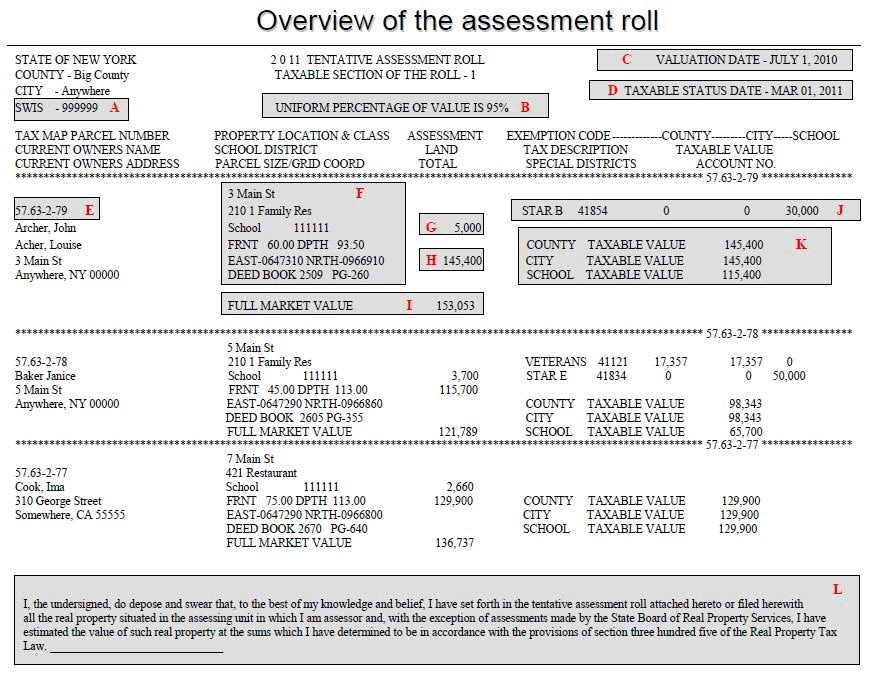Overview of the assessment roll

In most towns the tentative assessment roll is made public on May 1. The tentative roll lists assessment information for every property for the current year. It is your responsibility to check your assessment and exemptions on the tentative roll after it has been filed. Questions about your assessment should be directed to your assessor. After meeting with your assessor, if you are still dissatisfied, you have the right to file for a formal review by your Board of Assessment Review by the filing deadline.
A: SWIS (State Wide Information System)
A six-digit number assigned by the State as a unique identifier for every municipality in the state. The first two digits define the county, the second two the city or town, and the last pair the village, if any.
B: Uniform percentage of market value
New York State law requires that all properties in a municipality be assessed at the same percentage of market value. In this case, 95% means that the municipality is assessing property at 95% percent of market value.
C: Valuation date
In each municipality, property is assessed based on what its market value would have been on this date given its condition on taxable status date. In most towns, Valuation Date is July 1 of the year prior to the roll. (Please confirm the date in your municipality with your assessor.)
D: Taxable status date
The assessment reflects the ownership and physical condition of the property as of this date. In addition, most exemption applications must be filed with the assessor by this date. In most towns, Taxable Status Date is March 1 of the year in which the roll is filed. (Again, please confirm the date in your municipality with your assessor.)
E: Tax map parcel number
Also known as the Section-Block-Lot or SBL. This number will match the number on the tax bill, and is used when applying for exemptions and assessment review.
F: Property location and class
The code identifies the parcel's category (i.e., 210 falls within the 200 range, indicating a one family residence):
| 100's | Agricultural |
| 200's | Residential |
| 300's | Vacant |
| 400's | Commercial |
| 500's | Recreation, entertainment |
| 600's | Community service |
| 700's | Industrial |
| 800's | Public services |
| 900's | Wild, forested, conservation lands, public parks |
School district
The parcel's school district and school district code.
Parcel size
The parcel's frontal and depth dimensions.
Grid coordinates
The parcel's identification by geographical coordinates, used for mapping purposes.
Deed book
The volume number of the book (liber) and page number where deeds are recorded.
G: Land assessment
The assessed value of the land without the addition of improvements (permanent structures). By law, only the total assessment (H) may be reviewed (or grieved).
H: Total assessment
The total assessed value of the property, including the land and improvements.
I: Full market value
What a willing buyer would pay a willing seller under normal circumstances. This should approximate the dollar amount for which the property could be sold. In places where the uniform percent of market value is 100%, this is the same as the assessed value; otherwise market value multiplied by the uniform percentage of value (B) will be the total assessed value (H).
J: Exemption
The name of the exemption and the exemption code (in this case Basic STAR 41854), followed by the amount of the exemption for each taxing jurisdiction (i.e., STAR B is the Basic STAR exemption and applies only to school tax, thus the taxable value of the exemption for county and city is zero).
K: Tax description
Taxing jurisdictions include counties, cities, towns, school districts, villages and special districts (fire, sewer, water, etc.)
Taxable value
The value, after exemptions are applied, upon which your tax bill will be calculated (H minus J = K). In this case, the school taxable value is different from the others due to the STAR exemption.
L: Assessor's oath
This is only listed on the last page of the roll. The assessor signs the roll to indicate that all assessments are uniform at the stated percentage of market value.